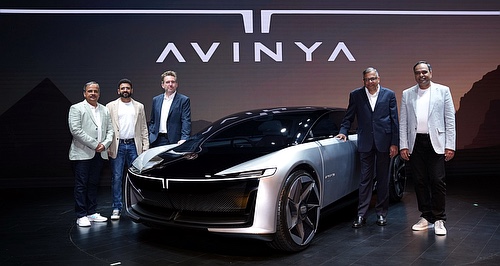Future models - Tata - EVTata shows off Avinya conceptCatamaran-inspired BEV promises up to 500km range from 30min charge, on sale 20253 May 2022 By MATT BROGAN TATA has unveiled the Avinya electric vehicle concept model, based on the Indian firm’s Gen 3 architecture and signalling a new identity for the Mumbai-based company.
Intended as a premium offering, the parent company of Jaguar Land Rover says the production version of the Avinya will be “fairly accessible to a majority of customers” when it is introduced to the market in 2025.
Showcasing Tata’s Sanskrit design language, the Avinya nameplate stands for ‘innovation’, the company says.
Its cabin design was based on a catamaran and is said to offer “enormous roominess and comfort” while “new age technology, software and artificial intelligence” work together to create “wellness and tranquillity during transit”.
The Avinya even features a built-in aroma diffuser a la Mercedes-Benz.
Specification details are scarce; however, Tata says the model will provide next generation connectivity, advanced driver assistance systems and enhanced performance and efficiency, the latter offering up to 500km driving range from a 30-minute charge.
The body of the Avinya is like that of the recently released Audi Urbansphere in that it embraces people-mover proportions and coach-style doors.
Further, the model’s short overhangs offer more interior space than is provided by conventional bodystyles, the Avinya offering swivelling front seats and camera-based rear-view mirrors, again just like its German counterpart.
There are few screens inside the cabin, Tata saying it wished to focus on a human-centric design and to reduce distractions.
It instead offers just a single screen set within the Avinya’s steering wheel. Natural light is brought in from the ‘Skydome’ ceiling, while voice-activated systems are said to provide a “deeper interface” for all passengers.
Construction of the Avinya has sustainability at its heart, and according to Tata comprises “next-gen materials” and a strategised design that allows lightweight materials and an optimised structure to provide “appropriate stiffness” to “help minimise the overall mass”.
“While making the Avinya Concept a reality, the central idea was to offer a mobility solution like no other – a state-of-the-art software on wheels that is well-designed, sustainable and reduces the planet’s carbon footprint,” said Tata and JLR chair Natarajan Chandrasekaran.
“Green Mobility is at the nucleus of TPEM, and the Avinya Concept is the perfect reflection of what the company stands for – a creation that will not only accelerate the adoption of EVs but also lead this movement.
“Furthermore, at the Tata group, we are uniquely positioned to bring all the expertise that is necessary to build these mobility solutions and we are confident that in years to come we will make a larger and sustainable impact not only in India but globally as well.”
It is not known if the Avinya shares the same Electric Modular Architecture (EMA) as earlier promoted by Jaguar Land Rover, that company known to be already developing electrified internal combustion, battery electric and fuel cell electric powertrains.
Last year, JLR said that more than £2.5 billion ($A4.47b) worth of annual investments will be made in the development of electrification technologies and the development of connected services.
“Together, we will help Jaguar realise its potential, reinforce Land Rover’s timeless appeal and collectively become a symbol of a truly responsible business for its customers, society and the planet,” said Mr Chandrasekaran.  Read more16th of February 2021  Jaguar to go all-electric from 2025Jaguar Land Rover details new Reimagine strategy, including shift to electric powerAll future models Alfa Romeo Alfa Romeo Abarth Abarth Audi Audi Aston Martin Aston Martin BMW BMW Bentley Bentley Chrysler Chrysler Chevrolet Chevrolet Dodge Dodge Citroen Citroen Ferrari Ferrari DS DS Ford Ford Fiat Fiat FPV FPV Foton Foton Haval Haval Great Wall Great Wall Honda Honda Holden Holden Hyundai Hyundai HSV HSV Isuzu Isuzu Infiniti Infiniti Jeep Jeep Jaguar Jaguar Lamborghini Lamborghini Kia Kia Lexus Lexus Land Rover Land Rover Mazda Mazda Maserati Maserati Mercedes-Benz Mercedes-Benz McLaren McLaren Mini Mini Nissan Nissan Mitsubishi Mitsubishi Peugeot Peugeot Opel Opel Proton Proton Porsche Porsche Renault Renault Ram Ram Saab Saab Rolls-Royce Rolls-Royce Smart Smart Skoda Skoda Subaru Subaru SsangYong SsangYong Tesla Tesla Suzuki Suzuki Toyota Toyota Volvo VolvoMotor industry news |
Click to shareTata modelsAll future models Alfa Romeo Alfa Romeo Abarth Abarth Audi Audi Aston Martin Aston Martin BMW BMW Bentley Bentley Chrysler Chrysler Chevrolet Chevrolet Dodge Dodge Citroen Citroen Ferrari Ferrari DS DS Ford Ford Fiat Fiat FPV FPV Foton Foton Haval Haval Great Wall Great Wall Honda Honda Holden Holden Hyundai Hyundai HSV HSV Isuzu Isuzu Infiniti Infiniti Jeep Jeep Jaguar Jaguar Lamborghini Lamborghini Kia Kia Lexus Lexus Land Rover Land Rover Mazda Mazda Maserati Maserati Mercedes-Benz Mercedes-Benz McLaren McLaren Mini Mini Nissan Nissan Mitsubishi Mitsubishi Peugeot Peugeot Opel Opel Proton Proton Porsche Porsche Renault Renault Ram Ram Saab Saab Rolls-Royce Rolls-Royce Smart Smart Skoda Skoda Subaru Subaru SsangYong SsangYong Tesla Tesla Suzuki Suzuki Toyota Toyota Volvo VolvoMotor industry news |
















Facebook Twitter Instagram